The 10 best laptops of CES 2025: from the Lenovo ThinkBook Rollable to the Razer Blade 16
Roller Blades were the notebook winners at CES this year
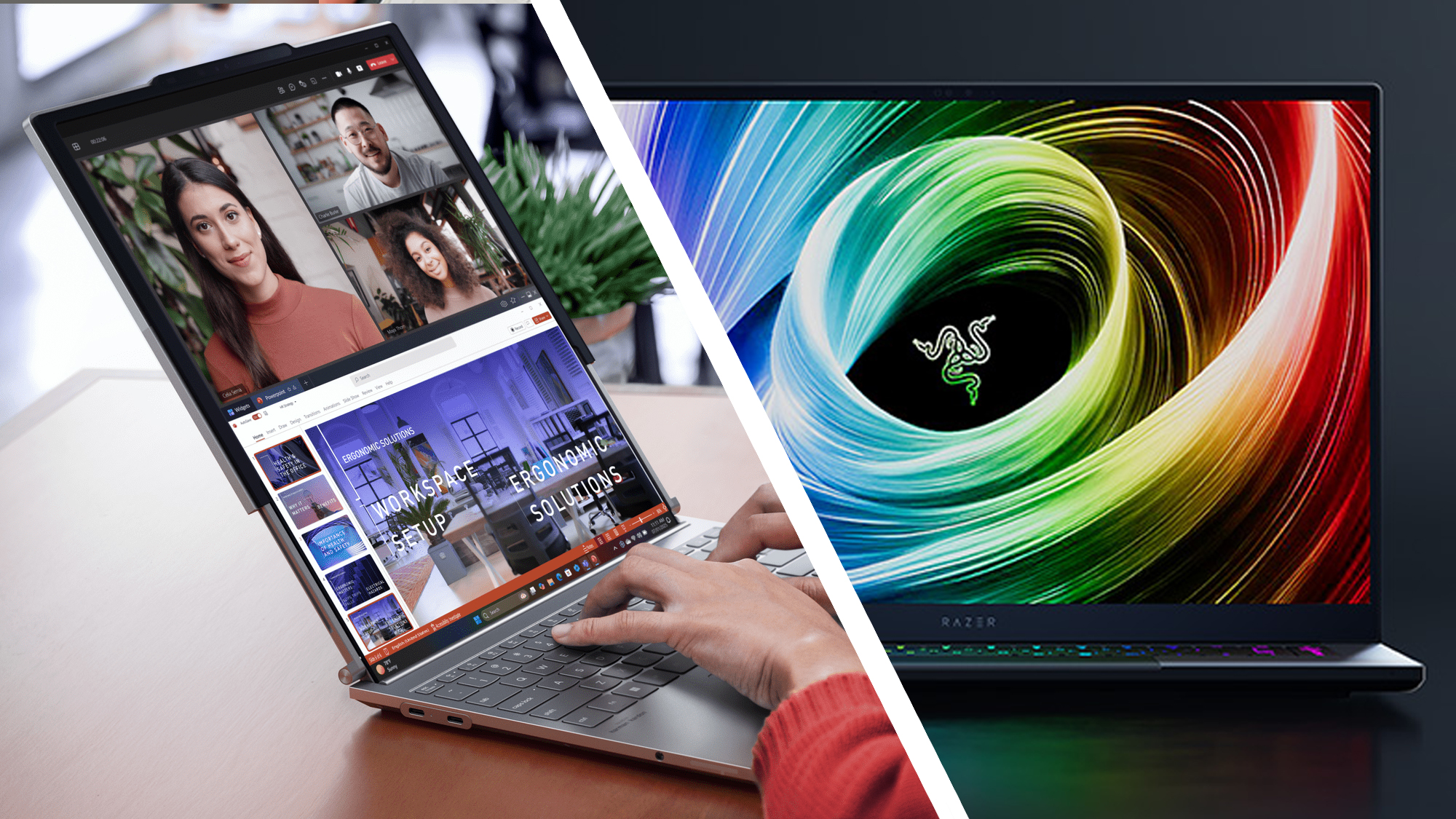
It’s another year, another Consumer Electronics Show, and for CES 2025 we’ve been treated to the by now expected raft of new laptops. This event is never short of notebooks, and equally never disappoints in terms of providing some new powerful and/or innovative products.
As is customary, we’re going to look at both traditional laptops and gaming notebooks here, splitting our top 10 in half between those models – with a number one taking home the winner’s trophy in each category.
The top laptop crop for 2025 includes a rollable device – which certainly scores highly in the innovation stakes – and an incredibly light Copilot+ PC, as well as a new Razer Blade that makes some bold changes to deliver what’ll hopefully be a standout gaming notebook for this year. Enough with the waffle, let’s press on with the best laptops of CES 2025 as we see it…
Laptops
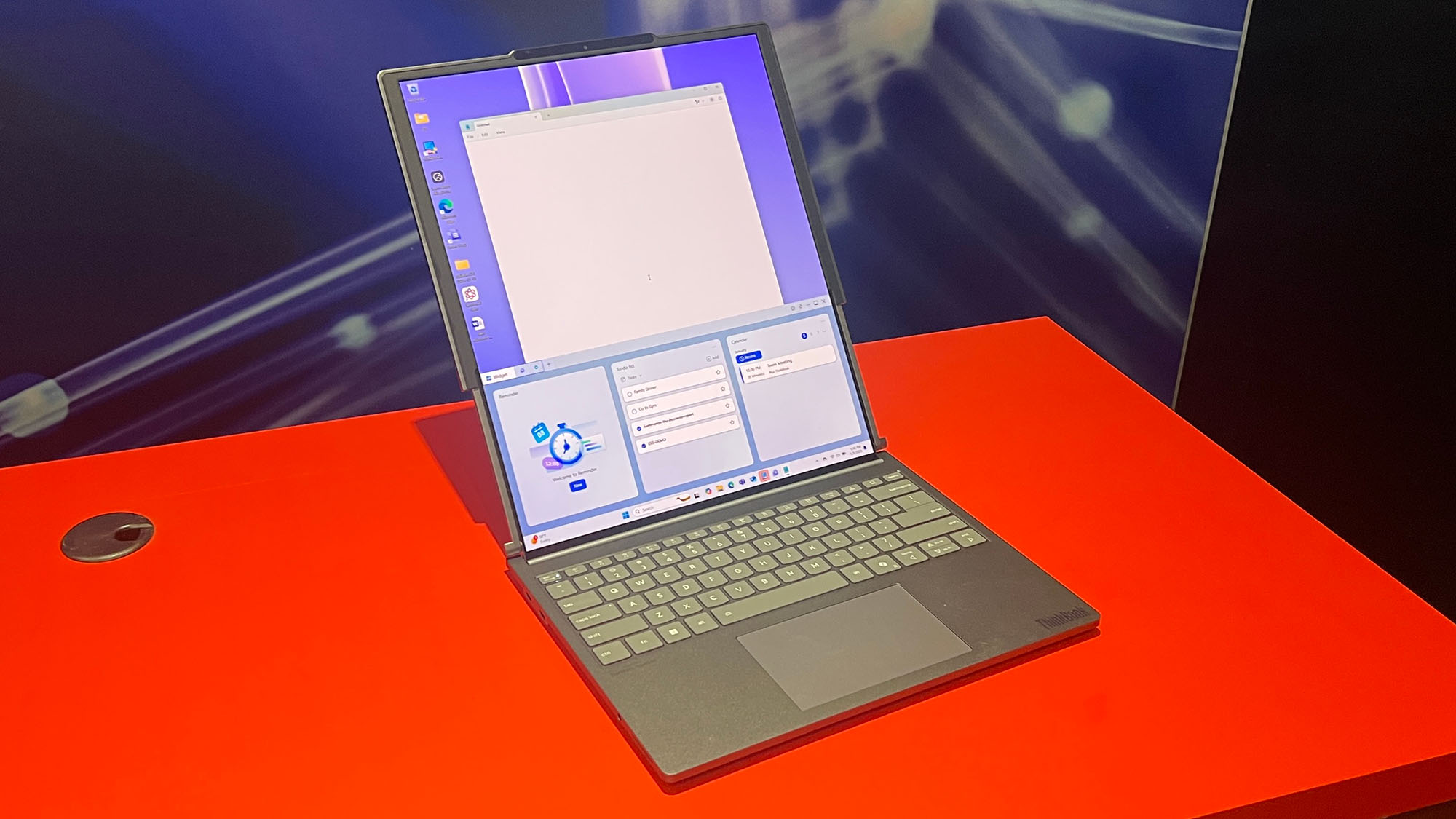
1. Lenovo ThinkBook Plus Gen 6 Rollable
A controversial number one? Well, maybe, but our top pick for the best laptop at CES 2025 is the rollable Lenovo ThinkBook. This is the first notebook in the world to have a rollable display, meaning that at the press of a button, the normal-sized screen can unfurl – rolling upwards – to make the display taller.
Okay, so it’s not a huge difference – the 14-inch screen transforms into a 16.7-inch effort – but that’s large enough to be able to use two apps, one above another, simultaneously, or have a tall screen to better view the likes of long documents, web pages, or coding work.
Spec-wise, the ThinkBook Plus Gen 6 Rollable comes with up to an Intel Core Ultra 7 Lunar Lake (200V) processor, up to 32GB of system memory, and up to 1TB of SSD storage.
Obvious problems? You might call vaporware on this, but Lenovo has actually given us a firm release date – of June 2025 – and even a price. That price is $3,499 in the US, which is another issue, really. Ouch.
Get daily insight, inspiration and deals in your inbox
Sign up for breaking news, reviews, opinion, top tech deals, and more.
Our other worry, that we expressed when this ThinkBook Plus Gen 6 was first leaked, is the mechanical workings of the rollable screen, and the extra points of failure they introduce for a notebook. Eventually, wear and tear with continual use could cause defects in the display, or the rolling mechanism might fail. With such an expensive device, that’s going to hurt if it happens.
Despite those concerns, we still feel this Lenovo rollable laptop deserves top billing purely due to the innovation being brought in here, with a real-world notebook (as opposed to a prototype), for the first time.
We don’t know how good the ThinkBook Plus Gen 6 and its rollable implementation will turn out to be yet, but this sort of innovation is important. Indeed, this kind of innovation is why we go to CES – to see fresh, bright, new ideas, not to witness a parade of refreshes with slightly more cutting-edge hardware. This sort of thing is what CES is all about showing off, frankly, so hats off to Lenovo, despite our worries around breakability.

2. Asus Zenbook A14
We’ll level with you: the Asus Zenbook A14 was almost our number one pick, getting edged out just because of the innovation element of the Lenovo rollable. Although that’s not to say there isn’t innovative thinking with the A14, certainly in its construction – this was a very close race, put it that way.
The Zenbook A14 is notable because it’s the world’s lightest Copilot+ PC, and a common theme for those who’ve been experiencing this notebook at CES 2025 is them marveling at how feather-like it feels in the hand with its ‘ceraluminum’ chassis. (Asus claims this material is “30% lighter and three times stronger than anodized aluminum” so the A14 sounds robust, too). The device weighs 980g (for the entry-level spec), and still manages to pack in a battery that can hit 32 hours of longevity (Asus claims in its video testing).
In terms of specs, the A14 has a 14-inch OLED screen with a Full HD resolution. There’s a Snapdragon X CPU (vanilla for the base model, or you can choose the Snapdragon X Elite), up to 32GB of RAM and 1TB of SSD storage. So, this is a very compelling mix of performance, portability and battery life, bearing in mind the issues around software compatibility (and possible performance dips with emulation) with Arm-based (Snapdragon) PCs.
Unlike the other laptops here, this one is actually on sale already, albeit only in the UK at £999 currently. Given that, it should be arriving imminently in the US (at $899) and Australia (price is TBC), or you’d hope so anyway. The Zenbook A14 looks hot in the value stakes given its price tag, build quality, and the power under the hood – not forgetting that OLED screen – and this is one notebook we’re very keen to get reviewing.
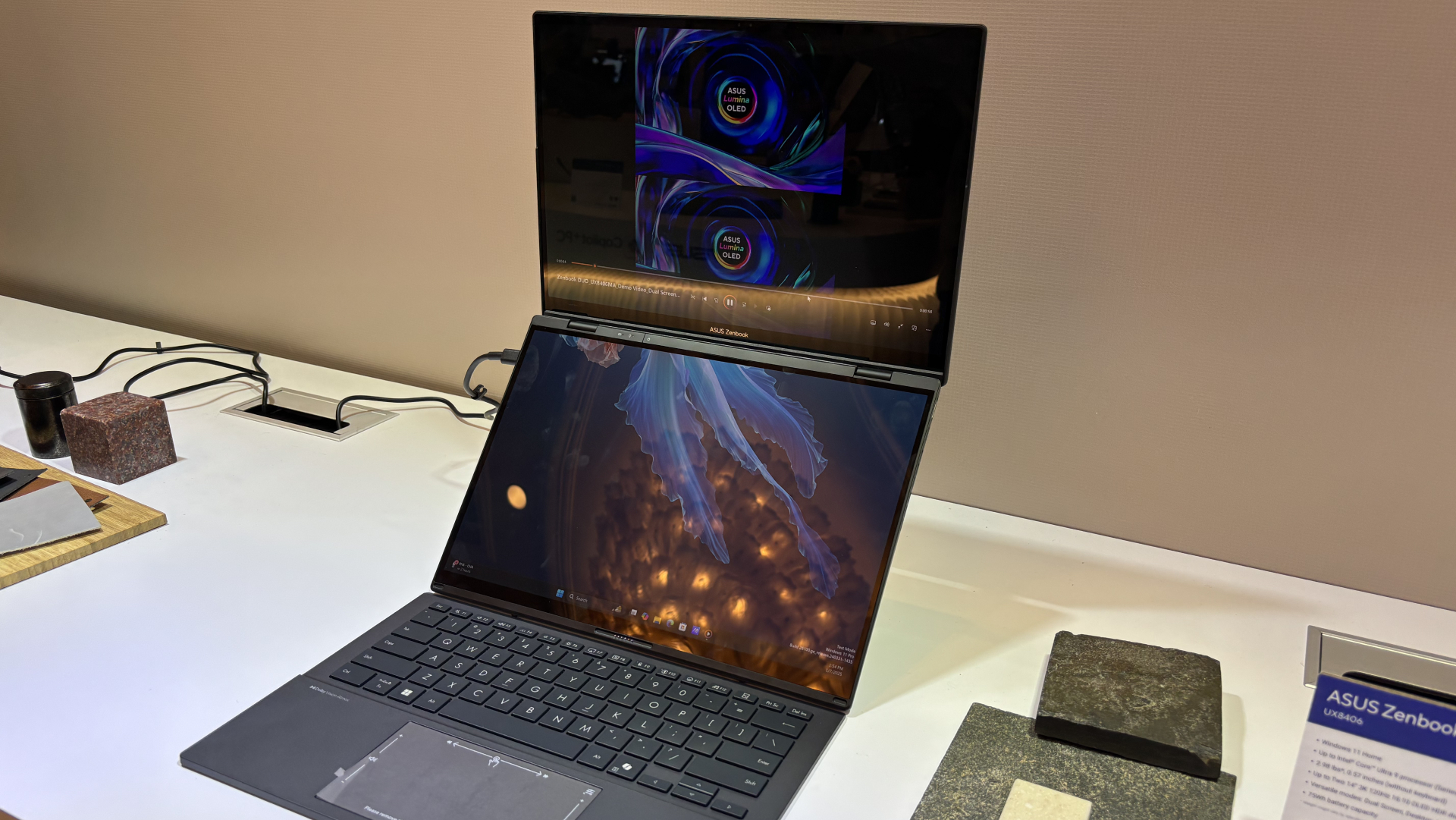
3. Asus Zenbook Duo (2025)
We took the new Asus Zenbook Duo for a hands-on spin at CES 2025, and to say it impressed us is very much an understatement. As a Zenbook Duo it does, of course, have two displays, 14-inch 3K resolution OLED touchscreens in fact, which is the central point of the laptop design here.
The Zenbook Duo can be used as a traditional laptop – with a physical keyboard that sits on top of the second screen – or you can detach the keyboard, and have the two displays, one atop the other, with the keyboard in front, as you see in the image above. There are other modes of use too, which is why we crowned this laptop as the “king of on-the-go functionality” after our time spent with the device.
The screens are gorgeous, you get up to an Intel Core Ultra 9 processor, and up to 32GB of RAM and 2TB storage, which means the Zenbook Duo should positively fly. The price of $1,700 in the US (UK and AUS pricing is still to be confirmed), given the premium nature and two screens, is relatively reasonable, especially given the Asus Zenbook Duo’s supreme versatility.
What we have in the end is a head-turning device with some real power behind it, and the main catch is that battery life isn’t the best (and that keyboard, when detached, is a tad on the flimsy side).
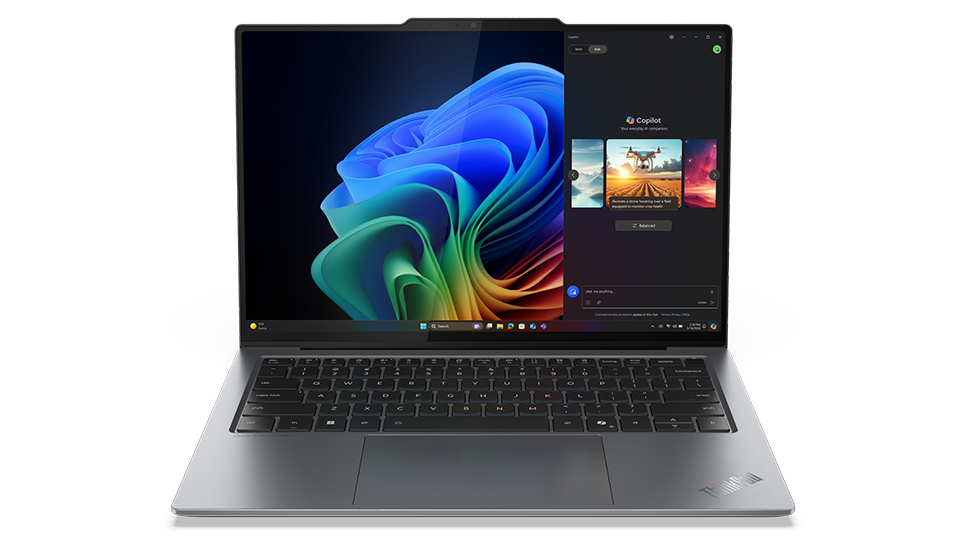
4. Lenovo ThinkPad X9 Aura Edition
Lenovo also introduced us to the ThinkPad X9 Aura Edition in 14-inch and 15-inch flavors at CES 2025, and made a positive impression. True, this is a business-targeted laptop, but with a ‘prosumer’ angle this time around, and a broader appeal.
This is a svelte notebook, yet durable (to MIL-SPEC 810H standard), and one of the key design aspects is what Lenovo calls an ‘engine hub’ which houses the ports (notably dual Thunderbolt 4 connectors, and HDMI 2.1). This also hosts the cooling solution, allowing the ThinkPad X9 to keep its Intel Core Ultra 7 (200V series, or Lunar Lake) processor suitably in-check for thermals, while ensuring the notebook remains laudably slim.
There are also some choices on top-notch OLED screens, along with up to 32GB of system RAM and up to 2TB of SSD storage. Furthermore, Lenovo has imparted some thoughtful design touches and eco-friendly aspects here – including covers made from 50% recycled aluminum, and a 100% recycled cobalt cell battery that’s fully replaceable by the laptop owner if it goes wonky over time. This new ThinkPad is close at hand, debuting in February 2025, starting from $1,399 and $1,549 in the US for the 14-inch and 15-inch models respectively.
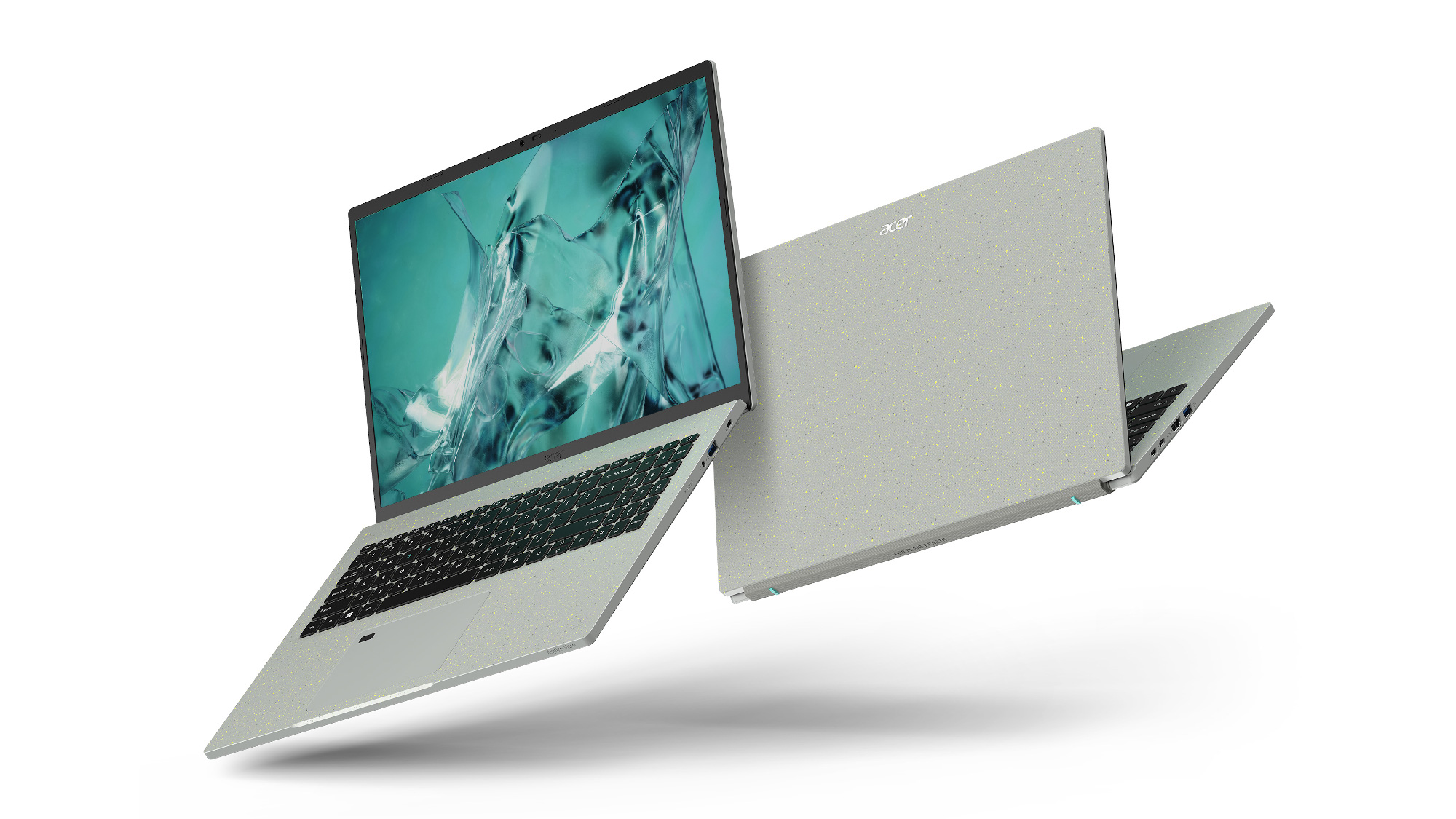
5. Acer Aspire Vero 16
While Lenovo offers up some impressive green tricks with the X9, if you want to go the whole eco-friendly hog, welcome to Acer’s latest Vero model.
This is a laptop built around sustainability, and the new Aspire Vero 16 has a chassis that’s manufactured using bio-based oyster shell material and over 70% post-consumer recycled plastic (plastic recycled by everyday people in their bins or at recycling stations). The touchpad is made from plastic retrieved from the ocean, too, and the laptop boasts an easy-to-repair design.
All that represents a big green-friendly tick which made the Vero 16 a CES Innovation Award Honoree this year. This 16-inch notebook packs Core Ultra 200H series processors (up to Core Ultra 7), featuring Intel AI Boost for speeding up AI workloads, and up to 32GB of memory and up to 2TB of storage. Vero 16 pricing will start at $799.99 in the US, with an April launch.
Gaming laptops

1. Razer Blade 16
Razer’s Blade 16 seriously impressed us at CES 2025, and indeed qualified as one of the best gadgets we saw at the show full-stop, out of everything there.
Razer has made some bold moves to sharpen its new Blade, one of which is a switch away from Intel CPUs to AMD for the first time – using the Ryzen AI 9 HX 370 to be precise. The Blade is, of course, all about being thin and portable as well as a powerful gaming laptop, and the switch to Ryzen may be all about helping the CPU to stay cool – relatively to the thermals of Intel chips – with Razer also innovating with a new vapor chamber cooling system.
All of which means the Razer Blade 16 is still thin – at some 0.59-inches (at its thinnest measurement) – while packing that peppy CPU and a new Nvidia RTX 5090 GPU (with 24GB VRAM) to really drive your frame rates high. This laptop also offers a 240Hz OLED display with a QHD+ resolution (3,200 x 1,800), plus an all-new keyboard.
We’re very excited about this launch, and it’s a fairly safe bet that the Razer Blade 16 will become one of our best gaming laptops when the device arrives at some point in Q1 2025 (pricing hasn’t been announced yet).
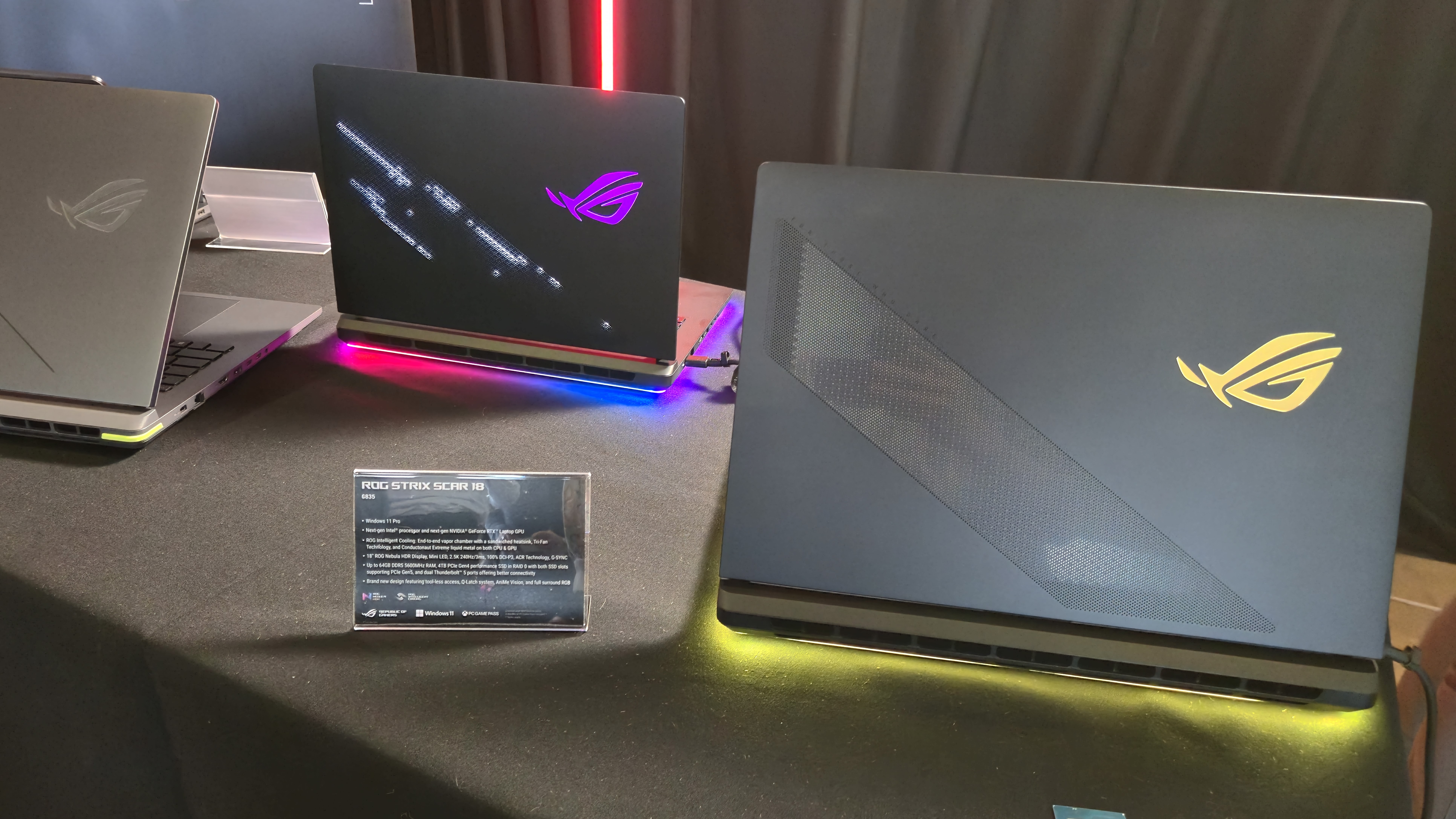
2. Asus ROG Strix Scar
Asus did very well at CES with laptops this year – this is the third (of four) on our list of the best – and the ROG Strix Scar, in 16-inch and 18-inch form factors, is a true powerhouse of a gaming notebook.
Let’s see, we have an (up to) Intel Core Ultra 9 275HX processor, twinned with (up to) an Nvidia RTX 5090 GPU, plus up to 64GB of RAM and up to 4TB of SSD storage. The SSD also benefits from a tool-less design so you can easily upgrade the drive.
On top of that, the ROG Strix Scar sports innovative cooling chops and a 2.5K mini-LED display (with over 2,000 dimming zones) featuring a 240Hz refresh rate and 3ms response time. This ‘Nebula HDR’ display offers a claimed 1,200 nits of peak brightness (don your shades now), 100% coverage of DCI-P3 for accurate colors, and a dual ACR layer to minimize reflections and pep up contrast.
It all sounds highly enticing, and this is another gaming laptop that qualified as one of our overall best gadgets of CES 2025, like the Razer Blade 16 – and we can’t wait to review both of these portables. Expect the Asus ROG Strix Scar to be expensive when fully loaded, of course, but we don’t have any pricing provided yet.
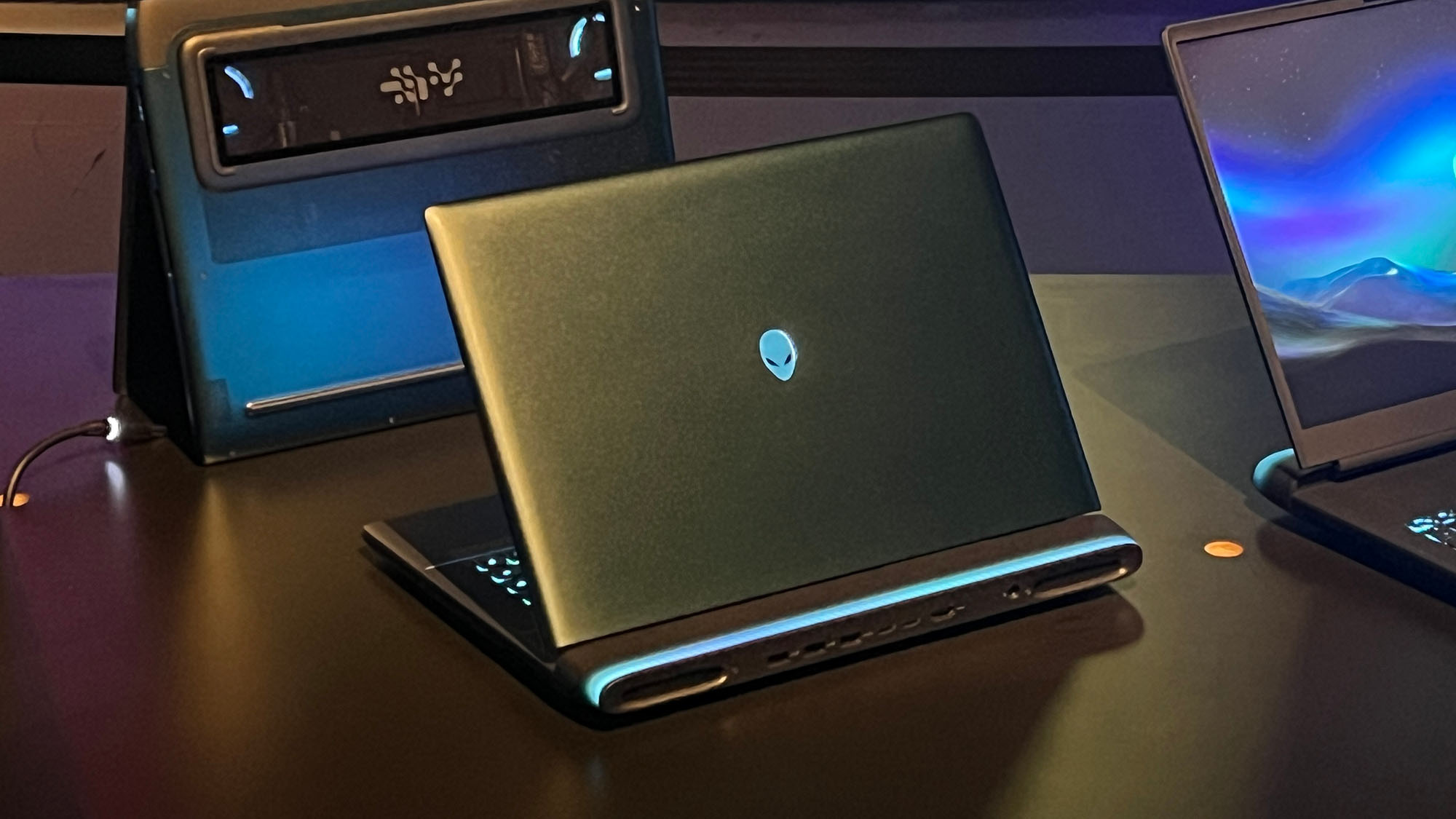
3. Alienware Area 51
Alienware’s Area 51 PCs are back, including a pair of gaming laptops that, like the ROG Strix Scar, will come in 16-inch and 18-inch sizes.
These Alienware beasts will outgun the Strix machines slightly on the CPU front, upping the ante to the Intel Core Ultra 9 285HX (rather than 275HX), but they’ll pack the same RTX 5090 GPU. An added bonus here is support for PCIe 5.0 SSDs, and you can configure up to 12TB of storage (which will doubtless get very pricey – still, it’s great to have options).
The aesthetics are predictably nifty here, with futuristic RGB lighting, and a glowing trackpad, no less, as well as glowing fans inside (that are visible through a glass panel on the underside of the laptop). If you want a different and cool-looking notebook, you’re certainly getting it – speaking of which, Alienware boasts that the cooling system itself is much-improved here (with 37% better airflow, while being 15% quieter, we’re told).
Alienware Area 51 models will hit shelves at some point in Q1 2025, led by higher-end options starting at an eye-watering $3,200 in the US, but baseline configurations will follow at more (relatively) affordable prices.
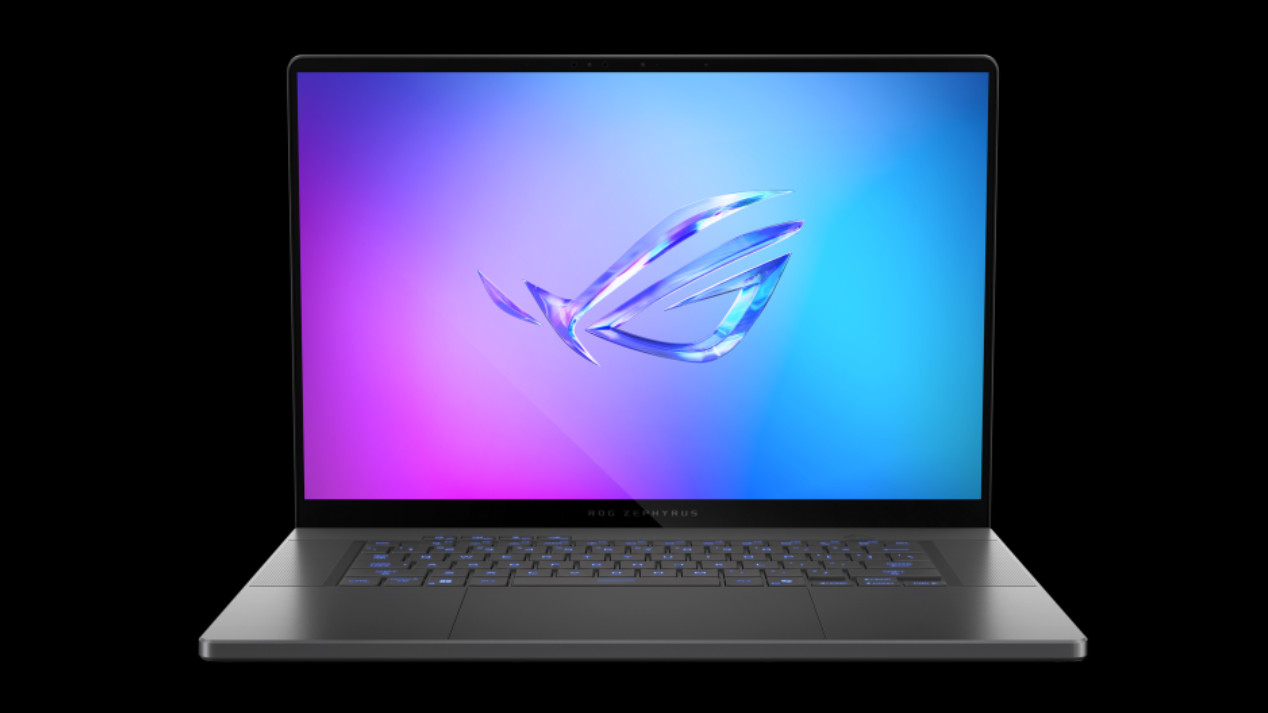
4. Asus ROG Zephyrus G16
Another (final) one from Asus, the ROG Zephyrus G16 is a sweet-looking gaming laptop that caught our eye at CES 2025.
Like the ROG Strix Scar above, the G16 benefits from a 2.5K ‘Nebula’ display, an OLED with a refresh rate of 250Hz and 500 nits brightness (peak). To drive 250 frames per second (to hit that refresh rate), you can have up to an Nvidia RTX 5090 GPU, partnered with an Intel Core Ultra 9 285H processor. (As you may have noticed, Intel’s new Arrow Lake laptop CPUs, Core 200H and HX, and Nvidia’s RTX 5000 GPUs, are featuring heavily as the mobile components to have at CES).
The G16 can be configured with up to 64GB of RAM, and 2TB of SSD storage, all packed into a chassis which is 14.9mm thin and weighs 1.85kg, so this is a nicely portable piece of gaming kit. Another one to watch from Asus for this year, for sure.
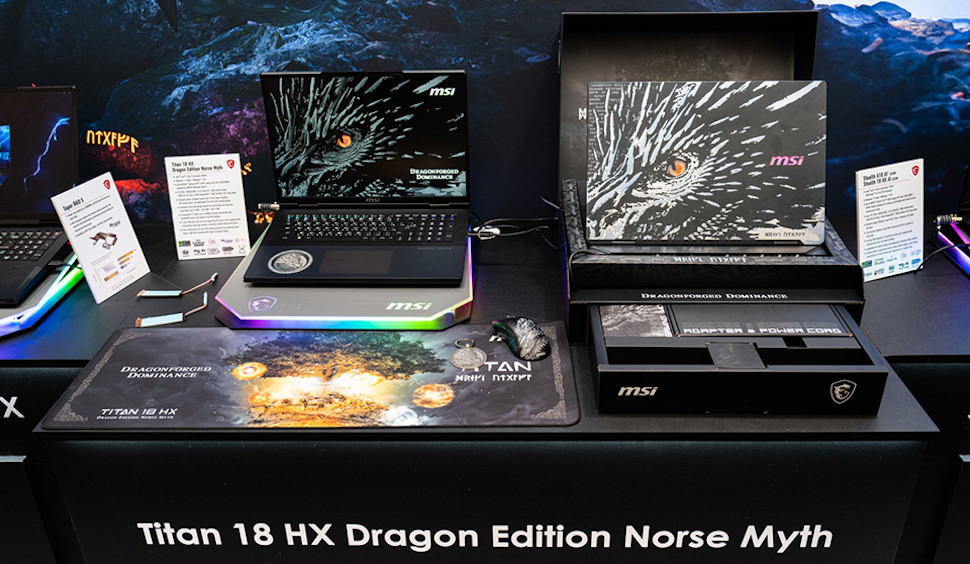
5. MSI Titan 18 HX
We’ve covered some powerful gaming laptops here, but what if you want to go really over-the-top with your next notebook? Let us introduce you to the MSI Titan 18 HX, or to give the device its full name, the Titan 18 HX Dragon Edition Norse Myth. (See what we mean – even the branding is over-the-top).
This really is a titanic laptop that features top-end components, with the Intel Core Ultra 9 275HX CPU, Nvidia RTX 5090 graphics card, and up to 96GB of system RAM. The 18-inch mini-LED screen is UHD+ (3,840 x 2,400 resolution, meaning 16:10) with a 120Hz refresh rate, 100% DCI-P3 coverage, and it’s VESA DisplayHDR 1000.
Connectivity includes two Thunderbolt 5 ports, you can fit in four PCIe Gen5 SSDs, there’s a 6-speaker audio system, and a Cherry mechanical RGB gaming keyboard, plus a lit touchpad (like the Alienware). The Titan 18’s metallic finish is adorned with “hand-drawn dragon motifs and Nordic runes” and there’s a dragon coin embedded in the chassis, on the left of the trackpad under the keyboard deck. This notebook doesn’t so much look striking as hit you in the skull with a bolt of Norse lightning.
As we said at the beginning, CES is about innovation, but it’s also about pedal-to-the-floor outrageousness too, and MSI has our attention grabbed on that front, make no mistake.
You might also like
Darren is a freelancer writing news and features for TechRadar (and occasionally T3) across a broad range of computing topics including CPUs, GPUs, various other hardware, VPNs, antivirus and more. He has written about tech for the best part of three decades, and writes books in his spare time (his debut novel - 'I Know What You Did Last Supper' - was published by Hachette UK in 2013).